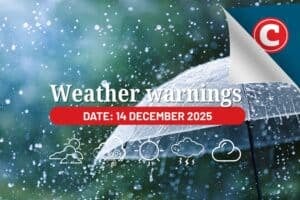It is the time of year when severe thunderstorms, accompanied by damaging winds and hail, can be expected as SA...

It is the time of year when severe thunderstorms, accompanied by damaging winds and hail, can be expected as SA heads into summer.
South African Weather Service spokesperson Hannelee Doubell said the rule of thumb was to be aware that the rainy season can bring hail.
“In summer you have the greatest risk. Not every thunderstorm has hail – but severe thunderstorms and tornadoes often have,” she added.
Not every thunderstorm has hail
Vox Weather meteorologist Michelle Cordier said hailstorms were most common from October to December in South Africa as it marks the beginning of the summer rainfall season.
“Early in this season, atmospheric conditions favour hail formation due to rising surface temperatures, combined with sufficient moisture and instability in the atmosphere,” she said.
“By late summer, the likelihood of hail decreases as the atmosphere shifts to a more tropical state, reducing the frequency of hail-producing storms.”
ALSO READ: More thunderstorms expected tomorrow
Cordier said hail prediction was challenging due to the localised and sporadic nature of hail events.
“While radar and satellite data, along with models like Hailcast, can identify atmospheric conditions conducive to hail, accurately pinpointing specific hail events remains difficult,” she said.
“The formation of hail is driven by strong updrafts within thunderstorms, where warm, moist air rises and cools, causing moisture to condense and freeze in a region called the freeze zone.
Hail prediction is challenging
“Collisions with other ice particles cause these hailstones to grow, eventually overcoming the updrafts and falling to the ground. Typically, a clash between warm surface air and cool, maritime air flowing inland further intensifies the updrafts needed for hail.”
Auto and General Insurance spokesperson Johanni Jennings said although vehicles were usually the hardest hit, major hailstorms also result in millions of rands in damages to roofs, windows, sliding doors, skylights and outdoor equipment.
“Homeowners who have installed solar panels are advised to ensure their building insurance has storm-related damages as an insured peril,” said Jennings.
ALSO READ: Severe thunderstorms with flooding expected to hit Gauteng this afternoon
“Most solar panels can withstand extreme weather conditions and take a bit of a beating, thanks to their protective and durable sheet of thick, tempered glass.
“Depending on the storm’s severity and the impact of the hailstones, the solar cells themselves can also be damaged. Spiked hailstones [hail clusters] and hailstones the size of a ping-pong ball, golf ball or tennis ball are the ones to watch out for when it comes to solar system damage.”
She said building insurance covers the loss or damage to the actual building structure as a result of fire or explosion, storm, flood, lightning strike and ground movement.
Insurance coverage
“Solar panels are fixed to the property and, therefore, covered under a building insurance policy,” she said.
“Solar panels do not need to be specified separately, but homeowners need to inform us and adjust their total sum insured accordingly.”
King Price Insurance client experience partner Wynand van Vuuren said it was important to know when thunderstorms are on the way to ensure that your car and home make it through the storms with minimal potential for damage.
NOW READ: Weather: Heavy downpours and severe thunderstorms for Gauteng North West, Free State and Limpopo






